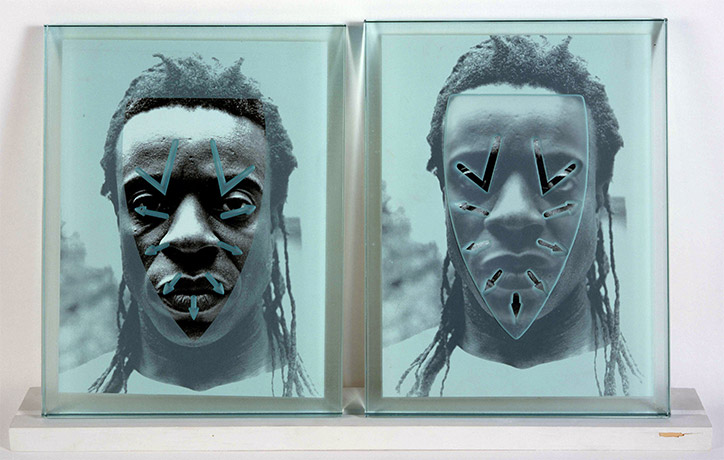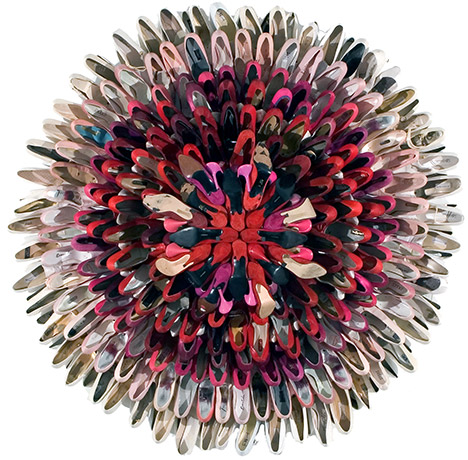Anxious Objects: Willie Cole’s Favorite Brands
June 23 - September 03, 2007
Anxious Objects: Willie Cole’s Favorite Brands showcases the methods, media, and themes of the artist’s earliest mature work from the late 1980s to the present. Cole is best known for assembled, mixed-media sculpture and paintings and drawings made of iron scorchmarks. He transforms throwaway and time-textured objects—such as irons, ironing boards, blow dryers, high-heeled shoes, lawn jockeys, bicycle parts, and other discarded domestic appliances and hardware—into powerful and iconic artworks, granting them new vitality and metaphorical meaning.
Cole’s works track his distinctive, Newark-based heritage, melding the social, political, and cultural perspectives of urban African American experience. He frequently ritualizes his found “western” objects, creating potent global artistic hybrids. Many of his sculptures’ forms and motifs are directly derived from African art.
While often witty, Cole’s reactions to African art motifs and forms are informed more by studious appreciation than by humorous imitation or ironic appropriation. Many of his works relate to issues of the urban experience and race in America, as well as to global concerns. Cole’s iconic objects connect capitalist materialism and the brands and branding of everyday life with aesthetics, enduring religious belief systems, and human pathos.
Beyond Cole’s direct adaptations of African art, his oeuvre can be connected to a wide range of artwork by specific historic and modern European and American sculptors and painters. An employment of everyday objects for art originates in Marcel Duchamp’s and Man Ray’s “readymades.” Cole’s use of consumer and industrial detritus also follows an arc from Pablo Picasso to David Smith to John Chamberlain, all of whom incorporated real objects in their sculptures. In addition, the bravado improvisatory playfulness of Cole’s masks and figure sculptures has a potent precedent in the piled-up fruits and other components of the sixteenth-century Italian Mannerist painter Giuseppe Arcimboldo.
Cole’s artistic emergence occurred between the poles of the Pop art of Andy Warhol and Claes Oldenburg and the Minimalism of Donald Judd and Sol LeWitt. His choice of American consumer subjects organized within formal, serial variations neatly unites these two seemingly opposed art movements. Finally, Cole’s exploration of racial identity and heritage places him within a remarkable generation of African American artists of the late 1970s and 1980s affiliated by their use of existing objects with powerful African American history and nostalgia-laden content. His post-modern and post-Minimalist peers include Chakaia Booker, Whitfield Lovell, Kerry James Marshall, Kara Walker, Carrie Mae Weems, and Fred Wilson, and such mentors as Mel Edwards, David Hammons, and Betye Saar.
Born in Somerville, New Jersey, in 1955, Cole received a B.F.A. from The School of Visual Arts, New York, in 1976. He has resided and worked in Newark, and now lives with his family in Mine Hill, New Jersey. The artist’s work is in numerous private and public collections, and he is represented by Alexander and Bonin, New York.
The first full survey of Cole’s work, Anxious Objects: Willie Cole’s Favorite Brands is curated by Patterson Sims, director of the Montclair Art Museum, and coordinated for the Frye by Robin Held, chief curator and director of exhibitions and collections. The exhibition is accompanied by a ninety-page, illustrated catalogue.
The exhibition was organized with support from the State of New Jersey, Department of Treasury; Agnes Gund and Daniel Shapiro; the Andy Warhol Foundation for the Visual Arts; Altria Group, Inc.; Ruth and William True; Merrill Lynch; the Cowles Charitable Trust; and the New Jersey State Council on the Arts/Department of State, a Partner Agency of the National Endowment for the Arts.
Willie Cole. G.E. Mask and Scarification, 1998. 2 panels, sandblasted glass with wood. 14 x 23 x 2 1/4 in. Collection of Catherine Woodard and Nelson Blitz, Jr.
Willie Cole. Wind Mask East, 1990. Blow dryers. 23 x 24 x 14 in. Courtesy of Alexander and Bonin, New York.
Willie Cole. Pretty in Pink, 2005-2006. Shoes, wood, metal pipe, screws, and staples. Diameter: 70 in., depth: 16 1/2 in. Courtesy of Alexander and Bonin, New York.


